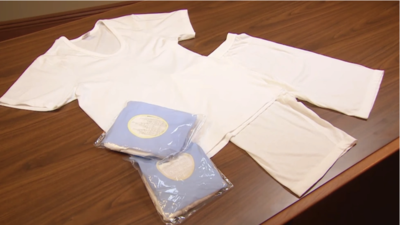
FAIR is a non-profit organization dedicated to providing well-documented answers to criticisms of the doctrine, practice, and history of The Church of Jesus Christ of Latter-day Saints.

Members of The Church of Jesus Christ of Latter-day Saints perform several sacred ordinances or ceremonies for individuals that they believe are necessary for individual exaltation. A few of these ceremonies are performed in temples: holy places dedicated to serving God.
As part of ceremonies in the temple known as initiatories, individuals put on sacred undergarments to symbolize some of the sacred promises that they make in the temple as well as sacred knowledge conferred upon them. These undergarments are commonly referred to as "the temple garment," "temple garments," "the garment," or simply "garments."
Members of the Church who go through these ceremonies and put on these sacred garments are sometimes confused as to two things:
This article seeks to answer these two questions given what we know from the temple and other official Church sources.
According to the official leadership handbook of the Church, “[m]embers who receive the endowment make a covenant to wear the temple garment throughout their lives.” A covenant is defined by the Church (and, indeed, by most dictionaries) as “a sacred agreement between God and a person or group of people. God sets specific conditions, and He promises to bless us as we obey those conditions.”
In the temple, we are asked to remain true to the covenants we make therein and to not defile the garment. In exchange, the garment will serve as a shield and protection. This clearly follows the definition of “covenant” above.
To “defile” means to violate the sanctity of something. To not wear garments when you have the reasonable opportunity to wear them (as discussed below) certainly falls in line with this definition.
The official leadership handbook section on wearing the garment states that “[t]he garment should not be removed for activities that can reasonably be done while wearing the garment. It should not be modified to accommodate different styles of clothing. The garment is sacred and should be treated with respect. Endowed members should seek the guidance of the Holy Spirit to answer personal questions about wearing the garment.” What are those activities where it might be unreasonable to wear the garment? Examples might include intimate relations between husband and wife, any period of intensive exercise, and any aquatic activity.
As noted, the garment should not be removed nor modified to accommodate different styles of clothing. One of the purposes of the garment is to encourage modesty in how we dress. The garment as currently designed indicates what parts of the body should be clothed in order to meet a more objective standard of modesty in how we dress.
Some have been concerned about having to be in extreme heat when wearing the garment. Retailers that sell garments carry it in a number of different fabric types to accommodate this. The chart below lists the different fabric types.
 Some women have been concerned about the garment causing yeast infections. It should be noted that all garment styles for women have cotton sowed into the groin area in order to try and prevent this. Special styles of garments exist for women who are pregnant and/or nursing. They also exist for those who are bed-ridden for an extended period or are terminally ill.
Some women have been concerned about the garment causing yeast infections. It should be noted that all garment styles for women have cotton sowed into the groin area in order to try and prevent this. Special styles of garments exist for women who are pregnant and/or nursing. They also exist for those who are bed-ridden for an extended period or are terminally ill.
Other questions about the wearing of the garment might be directed to God in prayer, a local bishop, and/or a local stake president.
Wearing the garment is a sacred privilege. They are expressly not "just like any other underwear." Wearing the garment communicates love for God by keeping his commandments and love for others by giving them an example to follow that leads them to our Savior Jesus Christ.[1] We often want so much to conform our garment-wearing to the world rather than help the world conform to garment-wearing. We shouldn’t be afraid to be different from others. The Lord has told us that, as Christians, we should “[l]et [our] light so shine before men, that they may see [our] good works, and glorify [our] Father which is in heaven.”[2] Being different by wearing our garments and treating them with sacredness is an excellent way that we can humbly follow the Lord and, by so doing, be peculiar and interesting to other people. This interest may lead them to explore the teachings of The Church of Jesus Christ and be converted to it. Thus, by wearing the garment we can fulfill the Lord’s commandment to be a light to the world. As Latter-day Saints, we should be model disciples of Jesus Christ. Wearing the garment is one way that we can do that. It brings tremendous spiritual blessings.
Notes

FAIR is a non-profit organization dedicated to providing well-documented answers to criticisms of the doctrine, practice, and history of The Church of Jesus Christ of Latter-day Saints.
We are a volunteer organization. We invite you to give back.
Donate Now